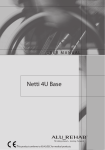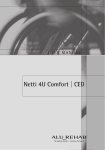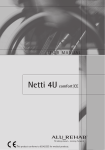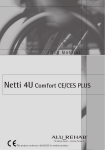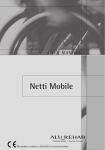Download Alu Rehab Netti 4U comfort CEDS User manual
Transcript
USER MANUAL Netti 4U comfort|CED(S) This product conforms to 93/42/EEC for medical products. CONTENTS 1. INTRODUCTION 4 1.1 Areas for use/indications for Netti 4U comfort|CED(S) 5 1.2 Contra-indications 5 1.3 Quality and durability 5 1.4 The environment and waste disposal 5 1.5 Information for re-use 6 1.6 About this manual 6 1.7 Vital measures 7 2. QUICK REFERENCE 9 3. DESCRIPTION 10 4. FEATURES OF NETTI 4U COMFORT|CED(S) 11 5. ACCESSORIES12 5.1 Assembly of Hip-Belt 14 6. ASSEMBLING AND ADJUSTMENT 6.1 6.2 6.3 6.4 6.5 6.6 6.7 6.8 6.9 6.10 6.11 6.12 6.13 6.14 Unpacking14 Main wheel15 Front castors 15 Seat height adjustment 15 Back rest 16 Seat depth adjustment at the rear 17 Seat depth adjustment in front 17 Anti tip 18 Seat cushion 18 Back rest cushion 18 Adjusting velcro back Foot support 19 Head support 21 Arm support 21 19 2 Language: English Model: Netti 4U comfort|CED(S) Model: November 2013 (05) 6.15 6.16 6.17 6.18 Adjusting the brakes Push bow Seat angle/tilt Back rest angle 23 25 26 26 7. MANOEUVERING THE WHEELCHAIR 7.1 7.2 7.3 7.4 7.5 7.6 7.7 7.8 7.9 General about driving and parking Driving techniques - Step up Driving techniques - Step down Driving techniques - Slope Driving techniques - Up stairs Driving techniques - Down stairs Transfer Lifting the wheelchair Push rim 26 27 27 28 28 29 29 30 30 8. TRANSPORT 8.1 Folding for transport31 8.2 Transport in a car 31 9. MAINTENANCE 9.1 Maintenance instructions32 9.2 Cleaning and washing instructions 32 33 11. TESTS & GUARANTEE34 10. TROUBLESHOOTING 11.1 11.2 11.3 11.4 11.5 11.6 11.7 Tests 34 Guarantee34 Claim 34 Spare part guatantee 35 Special adjustment/adaptations 35 Combinations with other products 35 Service and repair 35 12. MEASURES & WEIGHT 36 Language: English Model: Netti 4U comfort|CED(S) Model: November 2013 (05) 3 1. INTRODUCTION Netti 4U comfort|CED(S) is a comfort wheelchair meant for both indoor and outdoor use. It is tested to DIN EN 12183:2009. The tests were carried out by TÜV SÜD Product Service GmbH in Germany. In Alu Rehab we believe that wheelchairs should be chosen based on a thorough assessment focusing on the needs of the user and demands from the environment. Therefore it is important to know about the possibilities and restrictions of the wheelchair. Netti 4U comfort|CED(S) is a wheelchair designed for users with the need for comfort and relief. The combination between the seating system and the ergonomical solutions in the frame construction, offers many possibilities for adaptation and adjustments. The wheelchair is constructed for indoor and outdoor use, and offers the possibility to vary the sitting position from activity to rest using tilt and recline functions. Max user weight Netti 4U comfort|CEDS: 130 kg. Max user weight Netti 4U comfort|CED: 160 kg. When mounting accessories such as power kit etc., the weight of the accessories must be subtracted from the max user weight. Specifications varies between countries. 4 Language: English Model: Netti 4U comfort|CED(S) Model: November 2013 (05) 1.1 Areas of use/indications for Netti 4U comfort|CED(S) Netti 4U comfort|CED(S) is a multi-function wheelchair for partially or fully immobile persons with physical and/or mental disabilities. These disabilities may have multiple causes. Netti 4U comfort|CED(S) has an adjustable seat and back angle, thus facilitating for the user change of position, mobilisation or posture correction (stabilisation), wherever the following functional impediments with their multiple possible causes are present: • limited or lacking mobility • limited or lacking muscle power • limited movement range • lacking or limited trunk and body stability • hemiplegia • rheumatic-type disorders • craniocerebral injuries • amputations • other neurological or geriatric disorders 1.2 Contra-indications Netti 4U comfort|CED(S) is not suited for persons with a strongly enhanced muscular spasticity. In this case we recommend the Netti III, which offers a version with reinforced frame components and foot support for this particular need. Ignoring this advice could in unfavourable circumstances lead to the deformation or fracture of metal parts in the area of the back 1.3 Quality and durability The Netti 4U comfort|CED(S) wheelchair is tested at TÜV SÜD Product Service GmbH in Germany, following the European Standard DIN EN 12183:2009. As manufacturer, Alu Rehab A.S evaluates the test to be equal to 5-6 years of normal use of the chair. The disability of the user as well as the level of maintenance done foremost decides the durability of the wheelchair. Thus, the durability will vary depending on these two factors. 1.4 The environment and waste disposal Alu Rehab and its suppliers wish to protect the environment. This means: • That we avoid using environmentally harmful substances and processes to the greatest extent possible. • That Alu Rehab’s products are ensured a long service life and a high degree of flexibility - to benefit the environment and economy. • That all packaging can be recycled. • That the wheelchair was designed to be separated into its component materials - to make recycling easier. Contact your local recycling agent to get correct information how to handle in you area. Language: English Model: Netti 4U comfort|CED(S) Model: November 2013 (05) 5 1.5 Information for re-use All products from Alu Rehab are designed to give years of maintenance-free service. All products can be adapted for re-use by an authorised dealer. In order to guarantee performance and safety, Alu Rehab recommends the following tests prior to any re-use. Please examine the following components for function, integrity etc. and replace parts if necessary: • Wheels (tyre tread) • Wheelchair frame • Cushions • Hubs • Brake function • Headset bearings: test for wear lubrication • Directional stability of wheels • Bearings Please also note the content of chapter 9.2 Cleaning and washing Anti-tip Correctly fitted, the anti-tip will secure the chair from tipping backwards. We strongly recommend use of the anti-tips. 6 1.6 About this manual In order to avoid damages while using the Netti 4U comfort|CED(S) wheelchair, please read this manual carefully before starting to use the chair. Symbol of forbidden actions. No warranty can be claimed whenver these actions are implemented. Symbol of warning. Whenever this symbol is used, caution has to be taken. Symbol for important i information. Symbol for useful tips. Symbol for tools. Language: English Model: Netti 4U comfort|CED(S) Model: November 2013 (05) 1.7 Vital measures Netti 4U comfort|CED(S) is a comfort wheelchair designed for both outdoor and indoor use. Specifications varies between countries. Total weight: 28,5 Kg (500 mm width chair) Seat width: Netti 4U comfort|CEDS Specification min. Overall length with foot support 1080 mm - Overall width 700 mm - Folded length 610 mm - Folded width 630 mm - Folded height 560 mm - Total mass 28,5 kg - Mass heaviest part 2,5 kg - 0º 14º Static stability uphill 350, 400, & 430 mm Seat depth: (From back rest cushion to front of seat plate) 375, 400, 425, 450, 475, 500 mm Seat height: (From floor to top seat plate using 24” main wheels in upper hole position). 465 mm* *By changing position of main wheels, it is possible to achieve seat height of 500 mm. whewheel max. Seat plane angle -5º 20º Effective seat depth 425 mm 550 mm Effective seat width 400 mm 650 mm Seat surface height at front 465 mm 500 mm Backrest angle 92º 137º Backrest height 480 mm - Foot support to seat distance 280 mm 770 mm Leg to seat surface angle 105º 182º Arm support to seat distance 265 mm 355 mm Front location of arm support structure 320 mm 460 mm Push rim diameter 535 mm - Horizontal axle location -50 mm 25 mm Model width: 50 cm. Measured without cushions. Backrest height: 500 mm* * Using back rest extender gives 600 mm Language: English Model: Netti 4U comfort|CED(S) Model: November 2013 (05) 7 Total weight: 29 Kg (450 mm width chair) Seat width: 430, 450, 500, 550 & 600 mm Seat depth: (From back rest cushion to front of seat plate) 425, 450, 475, 500, 525, 550 mm Seat height: Netti 4U comfort|CED Specification min. max. Overall length with foot support 1130 mm - Overall width 700 mm - Folded length 660 mm - Folded width 630 mm - Folded height 560 mm - Total mass 29,5 kg - Mass heaviest part 2,5 kg - Static stability uphill 0º 28º Seat plane angle -5º 20º Effective seat depth 425 mm 550 mm Effective seat width 400 mm 650 mm Seat surface height at front 465 mm 500 mm (From floor to top seat plate using 24” main wheels in upper hole position). Backrest angle 92º 137º Backrest height 480 mm - 465 mm* Foot support to seat distance 280 mm 770 mm *By changing position of main wheels, it is possible to achieve seat height of 500 mm. whewheel Leg to seat surface angle Backrest height: 500 mm* * Using back rest extender gives 600 mm 8 105º 182º Arm support to seat distance 265 mm 355 mm Front location of arm support structure 320mm 460 mm Push rim diameter 535 mm - Horizontal axle location -50 mm 25 mm Model width: 50 cm. Measured without cushions. Language: English Model: Netti 4U comfort|CED(S) Model: November 2013 (05) 2. QUICK REFERENCE The content of this page is a summary of the whole manual. It gives a brief introduction to the use and care of the Netti 4U comfort|CED(S) wheelchair. The quick reference is not a replacement for the manual, only a reminder/check list. • Unpack the wheelchair (Chapter 6.1) • Mount the main wheels (Chapter 6.2) • Mount the front castors (Chapter 6.3) • Put the back rest back, and mount the recline gas strut to the back rest using the locking bolt. (Chapter 6.5) • Mount the cushions (Chapter 6.9 and 6.10) • Mount the foot supports (Chapter 6.12) • Mount the head support (Chapter 6.13) • Set anti-tip in active position (Chapter 6.8) • Mount accessory. (See chapter 5. for more information. Mounting descriptions will accompany the accessory.) For troubleshooting, see chapter 10. For mounting and adjustments see chapter 6. Drive carefully! Be aware that friction against push rims can create a warm surface. Salt water can increase risk of corrosion. Further precautions related to environmental conditions not needed. When the chair is tilted rearwards, the anti tips and brakes should always be in use. Be sure to lock all handles properly. The anti-tips should always be used for the safety of the user. Surface temperature of metal parts in frame structure might increase when exposed to direct sunlight. Never stand on the foot supports due to risk of tipping forwards. Never lift the wheelchair by the foot supports or arm supports. Product configuration may vary between different countries. For visually impaired people, manuals and catalogues can be downloaded at www.alurehab.com If in doubt - contact your dealer! Language: English Model: Netti 4U comfort|CED(S) Model: November 2013 (05) 9 3. DESCRIPTION Standard version* 1. Lock for push bow 2. Release handle 3. Push bow 4. Head support bracket 5. Angle and depth adjustment for head support 6. Head support 7. Back rest cushion, Uno 8. Arm support with pad 9. Seat cushion, Uno 10. Angle adjustable foot support 11. Calf support bracket 12. Calf support 13. Foot plate 14. Front castors 15. Front fork 16. Brakes 17. Anti tip 18. Main wheel 19. Knee upholstery 6 4 * Product configuration may vary between different countries. 10 3 7 8 19 2 1 9 18 12 17 10 13 If any of these parts are missing, please contact your dealer. 5 11 14 16 15 4. FEATURES OF NETTI 4U COMFORT|CED(S) Standard Accessories SEAT SEAT • Pressure distributive cushion • Tilt -5° to +20° • Adjustable depth of 12.5 cm • Trays & reading stand for trays (See chapter 5) • Hip belts (See chapter 5) WHEELS WHEELS • 24” x 1” Puncture proof main wheels with quick release axle • Push rim: Aluminium • 7” Puncture proof front castors with quick release axle • Puncture proof PU wheels 12”, 16” and 24” 1 with drumbrake (See chapter 5) • Puncture proof PU 24” 1/3/8 • Pneumatic wheels * Standard main wheels may vary between countries. BACK REST BACKREST FOOT SUPPORT FOOT SUPPORT ARM SUPPORT ARM SUPPORT • Angle: 90° to 135° • Height: 50 cm • The back rest cushion has integrated lumbar support and side support • Push bow • Angle adjustable foot support • Height- and angle adjustable foot plates • Removable • Height and depth adjustable • Back rest extender (See chapter 5) • Lumbar support and wedge (See chapter 5) • Different back cushions • Universal foot support • Hemi cushions (See chapter 5) HEAD SUPPORT • Height, depth and angle adjustable • Removable HEAD SUPPORT • Different head support models (See chapter 5) Language: English Model: Netti 4U comfort|CED(S) Model: November 2013 (05) 11 5. Accessories Belts Several variants: Hip belts with or without upholstery and with plastic lock or car lock. (See chapter 5.1 for mounting) Trays 2 models: Swing-able and lockable Upholstery for tray Offers a soft base for the arm resting on the tray. Wedge Increases side support. Lumbar support Increases lumbar curvature. Backrest Cushions Many to choose from. Please contact your dealer. Spoke protectors For 20”, 22” and 24”. Black or transparent is optional. Foot box Upholstered Foot supports: Angle adjustable Universal Adjustable in fixed positions between 33° to 105° using an adjustment wheel. Amputation support Vital Base Integral Pelvic stabilizer. Seat Cushions Many to choose from. Please contact your dealer. 12 Upholstery for calf support bracket Reduces pressure. Language: English Model: Netti 4U comfort|CED(S) Model: November 2013 (05) Head support Support C Large Support A Side support Support B Small Hygiene cover Protects the core of the head support. Head cushion 40x40 cm cushion with Kospoflex filling and rubber band. Head cushion Comfort Cushion with Kospoflex filling to pull onto head rest. Hemi cushion An accommodating support for hemiplegic users. Backrest extender 12 cm extender. To be used together with 60 cm back rest cushion. Main wheels 12”, 16”, 20”, 22” and 24” with drumbrake Foot board with lock The foot support can be swung to the side like standard foot supports. Side support Correction Meant for correction of bad postures in the upper trunk. Pad for side support Correction Side support Stable Meant for users with decreased stability of the upper trunk. For otimal function use together with Stable cushion. Pad for side support Stable Calf pad hinged The user doesn’t have to lift the leg when mounting or dismounting the foot supports. Upholstery for calf support bracket Reduces pressure Abduction block The block reduces abduction. Small: 80 mm width Medium:120 mm width Large: 140 mm width Anti tip Anti tip with tramp pedal Tool set Language: English Model: Netti 4U comfort|CED(S) Model: November 2013 (05) 13 5.1 Assembling of hip belt Illustration 5.1.1 • Pull the belt through the hole in the hip belt bracket. 6. ASSEMBLING AND ADJUSTMENT Ill. 5.1.1 Illustration 5.1.2 • Thread the belt back through the belt 6.1 Unpacking 1. Unpack all the parts, and check that clamp. everything is there according to the packing list. 2. Mount the main wheels (Chapter 6.2) 3. Mount the front castors (Chapter 6.3) 4. Check and adjust the seat dept (Chap. 6.6) 5. Mount the back rest (Chapter 6.5) 6. Mount the seat and back cushion (Chapter 6.9 and 6.10) 7. Mount the foot supports (Chapter 6.12) Ill. 5.1.2 8. Mount the head support (Chapter 6.13) Illustration 5.1.3 9. Mount any accessories (Chapter 5). • Fix the hip belt bracket to the back rest hinge in the rearmost hole, using the Weight of components (45 cm width chair): enclosed screws and nuts. Main wheels: 1,9 kg each Anti tip: 0,1 kg each Front castors: 0,8 kg each Foot support angle adj.: 2 kg each Uno|Back: 1,25 kg VB Sit: 1 kg Head support A: 1 kg Head support C: 0,9 kg Ill. 5.1.3 2 pcs13 mm open-end spanner 14 Language: English Model: Netti 4U comfort|CED(S) Model: November 2013 (05) Tools needed are described under each chapter. 6.3 Front castors Accessories described in chapter 5 To take off is a presentation of options and will be • Press the release button under the front delivered with sepearate mounting descriptions. fork. To mount • Lead the quick release axle into the 6.2 Main wheel bearing house. Pull the fork slightly to To mount the main wheel remove the ensure that the fork is fully locked. quick release bolt from the hub bushing, lead it through the centre of the main wheel and into the hub bushing while pressing the knob in center. 6.4. Seat height adjustment The seat height at the rear depends on: • Size of main wheel. • Position of main wheel. To check that the main wheel is properly attached to the hub, remove the finger from the central knob and pull at the main wheel. If the main wheel doesn’t lock, don’t use the wheelchair but contact your dealer. Sand and sea water (salt used for gritting in the winter) can damage the bearings of the main wheels and front castors. Clean the wheelchair thoroughly after exposure • Using 24” main wheels in the upper hole, the seat height is 46.5 cm from the floor to the seating plate. • Using 24” main wheels in the next upper position, the height will measure 50 cm to the seating plate. • Using 12” and 16” main wheels the seat height is 46.5 cm from the floor to the seating plate. If it is required to change position of the main wheels or to change to a different size of main wheels, unfix the hub bushing including washer and nut. Remove the hub bushing and mount it in the required position. 2 pcs. 24 mm open-end spanner. Language: English Model: Netti 4U comfort|CED(S) Model: November 2013 (05) 15 6.5 Backrest • To mount the gas spring, lift the push bow with one hand, and lead the gas spring locking head into the plastic bracket (Ill. 6.5.1). • Check that the hole in the locking head is parallel with the open holes in the plastic bracket. 2 pcs. 24 mm open-end spanner. Make sure that the nut on inside of frame totally wreathes the wheel bushing. Main wheels and front castors should be mounted according to the description below. 24”main wheel Ill. 6.5.1. • Lock the back rest by pushing the locking bolt through the plastic bracket and gas spring locking head (Ill. 6.5.2.) 24", 16" and 12" main wheel 24" 16" Ill. 6.5.2. To check that the back rest is When the seat height is changed ensure locked, grip the push bow and that the front castors are placed so press the back rest forward. If that the lower frame tube is parallel the back rest falls forward with the ground. repeat the locking procedure or contact your dealer. Check the position of the anti tip and readjust the brakes after moun• The wheelchair is set to a standard seat ting the main wheels or changing the depth, and the plastic bracket has 4 holes main wheel position. of which three are temporarily blocked with plastic plugs (Ill. 6.5.3). 24" main wheel 16 12" main wheel Language: English Model: Netti 4U comfort|CED(S) Model: November 2013 (05) 6.7 Seat depth adjustment in front Ill. 6.5.3 • The back rest hinge has 4 holes (Ill. 6.5.4) The hole positions are in accordance with the holes in the plastic bracket. If the locking head of the gas spring is mounted in the inner hole of the plastic bracket, the back rest hinge should also be mounted in the inner hole etc. By moving the seat plate and using the adjustment piece it is possible to increase the seat depth with 5 cm in front. This can be done when the back rest hinge is placed the thelongest depth of 45 cm. Do the following. • Screw out the screws in the adjustment piece (Ill. 6.7.) • Place the adjustment piece in the wanted position • Tighten the screws with 25 Nm. Ill. 6.7 6 mm Allen-key Ill. 6.5.4. 6.6 Seat depth adjustment at the rear. • If the seat depth should be adjusted at the rear, release the locking bolt from the plastic bracket (Ill. 6.5.2). • Find the required position for the locking head in the plastic bracket, and remove the plastic plug from this hole. In the outer edge of the seat plate there are 3 holes with 2.5 cm intervals. • Screw out the screws in the seat plate and move the seat plate forwards. (Each of the two positions increase with 2.5 cm. Total depth 5 cm. If the user has spastic tendencies the adjustment piece should not be pulled out more than 5 cm. 6 mm Allen-key Language: English Model: Netti 4U comfort|CED(S) Model: November 2013 (05) 17 6.8 Anti tip The anti tips should be mounted according to the mounting description which is enclosed with the chair upon arrival. Use of the anti tip • Pull the anti tip out • Turn it up or down 180°. • Lock it in position Adjusting the height of the anti tip The anti tip can be adjusted in to fixed positions. The short position is for 12” & 16” main wheels and 22” in upper position. The long position is for 22” main wheels in lower position. • Unfix the screw in the adjustable extension piece as shown in picture below. • This extension piece has two holes. Place it in the required position and tighten the screw 5 mm Allen key The anti tips must be changed if the main wheels changes to 20” or 22”. 6.9 Seat cushion The seat cushion is attached to the seat plate with velcro. It is very important to place the cushion in the wheelchair before use. 6.10 Back rest cushion The back rest cushion is attached to the back rest with the velcro. The seat and back rest cushion covers are washable and thereby reuseable. Follow the instruction on the cushions for correct maintanance and washing of the cushions. The anti tip should always be used for the safety of the user. 18 Language: English Model: Netti 4U comfort|CED(S) Model: November 2013 (05) 6.11 Adjusting the velcro back • Loosen the straps and place the back rest cushion so that the user gets room for the bottom and the integrated lumbar support in correct position. • Tighten the straps so that they follow the curvature of the spine and gives a little extra support at the top of the sacrum. Mounting of foot support • Grip the foot support in the hinge point. Hold it in an angle of app. 20° to the side frame. Put it into the plastic lock attached to the extractable adjustment bar. Swing it in and push down. 6.12 Foot supports The angle adjustable foot support is freely adjustable in angle. It is also swingable and removeable. The foot plates are foldable and can be angled in fixed positions. Delivered with height and depth adjustable calf support. Adjusting the angle • The angle of the foot support can be adjusted using the star wheel. • Loosening this star wheel enables you to adjust the foot support to the required angle. • Fix the angle by tightening the star screw. Language: English Model: Netti 4U comfort|CED(S) Model: November 2013 (05) 19 When moving the foot support up or down, do not put the fingers in the adjusting mechanism between the moving parts. Adjusting the length of the foot support • Untighten the screw (A) to make the adjustment tube move • Adjust the foot support in required position and fix the screw proper. Locking and releasing the foot plates • The foot plates come with a locking bolt which makes the plates stronger • To lock the foot plates pull the plastic lock on the right foot plate and place the lock over the bolt on the left foot plate. • To release the foot plate pull the plastic lock and lift the right foot plate up. While making the adjustment there must be no load on the foot plates. For outdoor use, there should be a clearance of 4-5 cm between the foot plate and the ground. When adjusting foot support in angle, be aware of squeeze hazard between moving parts. Removing the foot support: Adjusting the angle of the footplate • The foot plates can be adjusted in angle. • Untighten the screw (B) and adjust the foot plate to the required angle. Fix the screw properly. • Pull the plastic lock on the foot plate rearwards, so that the pin is released, and the foot plate can be folded up. • Raise the foot support a few degrees. • Release the foot support by pulling it slightly straight up. • Swing the foot support outwards. • Lift and remove the foot support. (ill. next page). 5 mm Allen key. 20 Language: English Model: Netti 4U comfort|CED(S) Model: November 2013 (05) Never stand on the foot supports! Never lift the wheelchair by the foot supports. 6.13 Head support Adjusting the calf support The calf support is height and depth adjustable. To adjust height unfix the nut on the outside of the calf support bracket, find the required height and fix the nut again (A). 10 mm open-end spanner A - Lever for depth adjustment B - Wheel for angle adjustment C - Lever for height adjustment D - Head support bracket To adjust in depth, the calf pad is removed from the bracket by using an open-end spanner between the pad and the bracket. Find the required position and refix it (B) 13 mm open-end spanner • Place the squared nut in the trace of the head support bracket as shown above. • Place the head support in the head support bracket. • The height and the depth of the head support is set to the required positions and tightened. Language: English Model: Netti 4U comfort|CED(S) Model: November 2013 (05) 21 Adjusting the head support sideways: • The head support adapter can be moved both to the right and left, giving the possibility to accomodate special needs for head support. • Untighten the four screws holding the adapter together. • Move the adapter to the required position and fix the adapter by tightening the screws diagonally. Remember to release the levers when adjusting the head support. • The head support bracket is fixed by tightening the four screws two by two diagonally so the bracket is fixed with the same strength divided on the four screws. Adjusting the head support in depth: • Release the locking lever on top of the vertical bar (A). • Adjust the head support and fix it in required position. Adjusting the head support in height: • Release the locking lever on the head support adapter (C). • Adjust the head support and fix it in required position. If the head support stand does not fit the bracket perfectly the bracket is probably fixed too tight or unevenly. After fitting the head support fix it properly by tightening the little set screw in the centre on top of the head support bracket using an Allen- key. If the head support seems to short in height, it can be turned 180° by releasing the adjustment wheel at the rear of the horizibtal bar (B) Adjusting the head support in angle: • Release the adjustment wheel at the rear of the horizontal bar (B). • Adjust the head support and fix it in required position. 22 Language: English Model: Netti 4U comfort|CED(S) Model: November 2013 (05) 6.14 Arm support • The arm support can be swung backwards Adjusting the height of the arm support • Untighten the screw on the arm support using a 4 mm Allen key. • Raise or lower stem • Tighten the screw A • Press the red handle to release the arm support for to swing it backwards Be aware of the arm support lock (A) that with resetting it will stick out a small amount. When side support is mounted on the wheelchair, it will not be possible to revolve this arm support. Adjusting the depth of the arm support • Press the red knob for to adjust the depth of the arm support. Be aware of potential squeeze hazard between arm support and top frame tube when locking arm support. 6.15 Adjusting the brakes • The brakes are freely adjustable along the frame tube. Language: English Model: Netti 4U comfort|CED(S) Model: November 2013 (05) 23 • To activate the brake, push the handle forward (Ill. 6.15.1) Ill. 6.15.4 Ill. 6.15.1 • To release the brake, pull the handle rearwards (Ill. 6.15.2). 5 mm Allen key Check that the brakes are correctly adjusted by activating the brakes and be sure that the wheelchair doesn’t move. The brakes are constructred as parking brakes and shall not be used as drving brakes Ill. 6.15.2 • To reposition the brake, loosen the two screws on the inside of the brake clamp (Ill. 6.15.3). Drum brake If the wheelchair is mounted with 12” or 16” main wheels, these will be equipped with drum brakes. Ill.6.15.3 • For fine adjustment, loosen the upper screw on the inside of the brakes (Ill. 6.15.4) • Adjust the brake position and tighten the screws. 24 If the brake doesn’t brake properly: To adjust the wire on one or both sides, adjust the foot screw 2-4 rounds out. Then re-check the brakes. Language: English Model: Netti 4U comfort|CED(S) Model: November 2013 (05) • For to put on and lock the parking brake (2) press the lever (1) against the push handle and lock the parking brake with the finger. Be sure that both parking brakes are locked. • The parking brake will be released when you press the lever (1) against the push handle. It is locked with a spring and this will in this way be released. If the wire is too loose: Adjust the foot screw all the way in. Tighten the wire by loosening the wire clamp before pulling the wire further through it. Tighten the wire clamp, and adjust the foot screw out again 1 pc 10mm open-end spanner. To ensure the correct functions of the wires, these must never be taut. It is extremely important that the parking brakes are locked when the user is left sitting in the wheelchair. Don’t leave the user in the wheelchair wihout to put the parking brake in function. 6.16 Push bow The push bow is handle adjustable. Operating and applying the brake The wheelbase in drum brake is fitted with hand operated hub brakes to allow regulation of speed on hills and whilst travelling along. These are located on the push handles 1 2 Ill. 6.16.1 • Open the handle for to change the angle of the push bow (Ill. 6.16.1) • To apply the brakes, pull the brake levers (1) evenly and smoothly towards handle and bring the wheelbase to a stop. Language: English Model: Netti 4U comfort|CED(S) Model: November 2013 (05) 25 The release handles have the following labels: Ill. 6.16.2 • Lock the handle after placing the push bow in the required position. ( Ill. 6.16.2) 6.17 Seat angle/tilt The seat angle is regulated using the release handle mounted on the push bar. The seat unit can be tilted from -5° to +20° Recline Tilt Risk for tipping. Check the position of anti tip. Don’t leave a user in the wheelchair when it is tilted forward. 7. MANOEUVRING 7.1 General techniques 6.18 Back rest angle The back rest angle is regulated using the release handle mounted on the push bar. The angle can be regulated from 90° to 135° . To ensure the correct function of the wires, there must never be taut. The seat and back rest angle must not be adjusted without using the anti tips 26 The weight and balance of the chair influences the manoevring qualities of the wheelchair. The weight, size and sitting position of the user are also influencing factors. The position of the wheels will in addition influence the manoevring qualities. The more weight placed over the main wheels, the easier it is to manoevre. If heavy weight is placed over the front castors, the chair will be heavy to maneuvre. Companion: If the user is left alone in the wheelchair, always lock the brakes and check that the anti tips are turned down. Parking: Increase the underneath support of the wheelchair by moving the chair about 10 cm rearwards making the front castors turn forward. Language: English Model: Netti 4U comfort|CED(S) Model: November 2013 (05) Parking: Companions, drive up a step backwards: 7.2 Driving techniques - Step up- • Check that the anti tip is turned up • Pull the chair backwards next to the step • Angle the wheelchair backwards, moving the front castors slightly up in the air. • Pull the wheelchair up the step and go backwards long enough to put down the front castors on the step. Turn the anti tip downwards. Increase the underneath support of the wheelchair by moving the chair about 10 cm rearwards making the front castors turn forward. Companions, drive up a step forwards: • Check that the anti tip is turned up. • Angle the wheelchair backwards. • Balance the chair on the mainwheels and push it forward until the front castors are on the step. • Lift the push handles while pushing the chair onto the step. Turn the anti tip downwards. 7.3 Driving techniques - Step downCompanions, drive down a step forwards: • Check that the anti tip is turned up • Angle the wheelchair backwards, moving the front castors slightly up in the air. • Drive carefully down the step and angle the wheelchair forward putting the front castors back on the ground. Turn the anti tip downwards. Users, drive up a step backwards: This technique is only useful if the step is very low. It also depends on the clearance between the footplates and the ground. • Check that the anti tip is turned up. • Drive the chair backwards towards the step • Make a firm grip on the push rims and move the body forward while pulling. Turn the anti tip downwards. Companions, drive down a step backwards: • Check that the anti tip is turned up. • Move the wheelchair backwards to the step. • Drive carefully down the step and move the wheelchair backwards on the main wheel until the front castors have come away from the step. • Put the front castors down on the ground. Turn the anti tip downwards. Language: English Model: Netti 4U comfort|CED(S) Model: November 2013 (05) 27 7.4 Driving techniques - Slope - Important advise for driving down and up hill avoiding the risk of tipping. Avoid turning the wheelchair in the middle of a slope. Always drive as straight as possible. It is better to ask for assistance than taking risks. 7.5 Driving techniques - Up stairs Always ask for assistance. Never use escalators, even if assisted by a companion. With assistance, backwards. • Check that the anti tip is turned up, • Pull the wheelchair backwards to the first step of the stairs. • Angle the wheelchair backwards on the main wheels. • Pull the wheelchair slowly up the stair, one step at the time keeping the balance on the main wheel. • Reaching the top of the stair, pull the wheelchair backwards far enough to put the front castors safely down on the floor. Turn the anti tip downwards. If two companions are present, one person can assist lifting in the front of the frame. Do not lift the wheelchair holding onto the foot supports.1 Driving uphill: Move the upper part of the body forwards in order to maintain the balance of the chair. Driving downhill: Move the upper part of the body backwards to maintain balance of the chair. Control the speed of the chair by clutching the push rims. Do not use the brakes. 28 Language: English Model: Netti 4U comfort|CED(S) Model: November 2013 (05) 7.7 Transfer Do not lift the wheelchair holding onto the arm supports. Techniques for transfering to/from the wheelchair should be practiced well with the persons involved. Here, we give some important advices for preparation of the chair. The companions should use the strength in their legs carrying the chair, avoiding unnecessary stress on the back. With or without companion - sideways. Before transfer: • The wheelchair should be placed as close as possible to the destination of the transfer. • Pull the wheelchair backwards 5-10 cm in order to make the front castors turn forward. • Lock the brakes. • Remove foot support and arm support on the side of the transfer. 7.6 Driving techniques - Down stairs Never use escalators, even if assisted by a companion. With assistance, forwards • Check that the anti tip is turned up • Drive the wheelchair forward to the first step of the stair. • Angle the wheelchair backwards on the main wheels. • Have a firm grip on the push bow, and keep the balance on the main wheel taking one step at the time • Reaching the bottom of the stair, put the front castors safely down on the floor. Turn the anti tip downwards. If two companions are present, one person can assist lifting in the front of the frame. With or without companion – forwards. Before transfer: • The wheelchair should be placed as close as possible to the destination of the transfer. • Pull the wheelchair backwards 5-10 cm in order to make the front castors turn forward. • Lock the brakes. • Tilt chair forward Do not lift the wheelchair holding onto the foot supports. Do not lift the wheelchair holding onto the armrests. Language: English Model: Netti 4U comfort|CED(S) Model: November 2013 (05) 29 Using a lift: Before transfer to chair: • Tilt the chair back • Remove the head support • Remove the foot supports • Open the back rest angle slightly • Replace the components when transfer is finished. Never lift the wheelchair in the foot supports or arm supports Never lift the wheelchair with a user in it. 7.9 Push rim Netti wheelchairs are delivered with aluminium push rims as standard. The material and distance to the main wheel influences the ability of the user to grip. Contact your dealer to get information about push rims that fit your chair. Alternative push rims may give a better grip, but the friction may increase. When using the hands to stop the chair, the risk for burning of the hands increases. Never stand on the foot plates without making sure that they are touching the ground due to the risk of tipping the chair forwards. 7.8 Lifting the wheelchair • The wheelchair should be lifted in the frame only and it is marked with symbol (ill. 7.8.1) where it should be lifted. Ill. 7.8.1 x Ill. 7.8.2 Never lift the wheelchair with in the the push bow,. This is marked with symbol (ill.7.8.2). 30 A squeezing and trapping hazard of the fingers may occur when passing through narrow passages and if the fingers come between the spokes. To avoid this risk, we recommend spoke protectors as accessory. If you want/need to change push rims or increase/decrease the distance between the push rims and the wheel, please contact your dealer Language: English Model: Netti 4U comfort|CED(S) Model: November 2013 (05) 8. TRANSPORT Netti 4U comfort|CED(S) is tested and approved to crash test ISO 7176-19. 8.1 Folding for transport In front: Use hook or strap attachment. When wheelchair is unoccupied, fold as described below. Put wheelchair in trunk or back seat. When placed in back seat, secure frame using safety belt. • Remove the head support (Chapt. 6.13) • Turn the anti tips upwards (Chapt. 6.8) • Remove the foot supports (Chapt. 6.12) • Pull out the locking bolt for the back rest, and place the back rest forward in the seat (Chapt. 6.5) • Remove the main wheels (Chapt. 6.2) • Remove the front castors (Chapt. 6.3) 8.2 Transport in car If the head support is mounted correctly it is very stable but does not replace the need for an external neck support mounted in the car. The chair is marked with stickers in 4 positions, showing where to fix the straps Netti 4U comfort|CED(S) has been successfully tested according to the requirement of ISO 7176-19 using a combined wheelchair an occupant restraint system W120/DISR developed by Unwin Safety Systems. For further information: www.unwin-safety.com Mount an “eye-bolt” in one of the holes in the wheel frame bracket. Hook on a hook/ carabine hook in the “eye-bolt” Item number 1 pair eye bolts with bushing: 21074 The angle of the straps should be 0-45° Language: English Model: Netti 4U comfort|CED(S) Model: November 2013 (05) 31 Netti 4U comfort|CED(S) has been crash tested without any power kit etc. If, at a later point of time a power kit, stair climber etc. is mounted this must be dismounted if the wheelchair is to be transported 9. MAINTENANCE 9.1 Maintenance instructions Frequency Weekly Check defects/damages E.g. breakage/missing parts Monthly X Washing of wheelchair X Oiling of bearings* X Washing of cushions X Check anti tip function X Check brake adjustment X Check tyre wear X * As a rule of thumb, use oil on movable The Netti chairs are built of modules. Alu parts and all bearings. Alu Rehab recommends use of ordinary bicycle oil Rehab carries stock of all parts and is ready to supply these on short notice. Necessary instructions for mounting will 9.2 Cleaning and washing follow the parts. 1. Remove cushions before washing Parts to be handled by user are defined the wheelchair. in spare part catalogues that can be 2. Clean cushions and covers according to downloaded at www.alurehab.com. These instructions printed on cushions. parts can, if needed, also be removed and Cushion cleaning procedures sent to manufacutrer/distributor upon CORE request. Parts related to wheel frame construction Washing Hand wash 40ºC must be handled by manufacturer or Virkon S Disinfection authorized sercvice facility. Auto clave 105ºC You can order original paint from Alu Rehab to repair scratches and minor damages to the paint: Please contact your dealer to order. If defects or damages occur, please contact your dealer. Check/re-adjust screws and nuts at regular intervals. Sand and sea water (salt used for gritting in the winter) can damage the bearings of the front castors and main wheels. Clean the wheelchair thouroughly after use. 32 Drying Squeeze Air dry standing edgewise OUTER COVER Washing Machine wash 60ºC Drying Tumble dry max 85ºC 3. Clean frame using water and a rag. 4. If jet water washing, avoid pointing directly towards gas springs, labels and back cushion. 5. We recommend using soft soap. 6. Wash the wheelchair well using clean water to remove all the soap. 7. Use methylated spirit to remove any dirt left. Language: English Model: Netti 4U comfort|CED(S) Model: November 2013 (05) We recommend washing the wheelchair in washing chamber at >85° C. For small damages to the surface, original surface paint can be ordered from the manufacturer. 10. TROUBLESHOOTING Symptom Reason/Action Reference in manual The wheelchair is going askew • The main wheel hubs might be incorrectly mounted • One of the brakes might be too tight • The user is sitting very askew in the chair • The user might be stronger on one side than the other The wheelchair is heavy to manoeuvre • The main wheel hubs might be incorrectly mounted • Clean the front castors and forks for dirt • Too much weight over the front castors 6.4 The wheelchair is hard to turn • Check that the front castors are not fixed too hard • Clean the front castors and forks for dirt • Check that the front castors are placed in correct position 6.3 The main wheels are difficult to take off and put on. • Clean and grease the quick release • Adjust hub bushing further out from the frame 6.4 The brakes are not functioning well • Adjust the brake 6.12 The wheelchair feels ”shaky” • Check screws and adjustment points in general 6.4 6.12 6.3 6.4 Please contact your dealer for information about authorized service facilities that can give support if solution is not reached in this form. When in need of spare parts, please contact your dealer. When making changes affecting frame construction, contact dealer / manufacturer for confirmation. Language: English Model: Netti 4U comfort|CED(S) Model: November 2013 (05) 33 11. TESTS & WARRANTY 11.1 Tests Netti 4U comfort|CED(S) is tested and has been approved for usage both indoors and outdoors. The chair is CE marked. Maximum user weight Netti 4U comfort|CEDS: 130 kg Maximum user weight Netti 4U comfort|CED: 160 kg It is tested by TÜV SÜD Product Service GmbH according to DIN EN 12183: 2009. Crash tested at Millbrooke Proving Ground, Bedford UK, according to ISO 7176-19 Seating system is tested for fire resistance according to: ISO 7176-16 11.2 Guarantee Alu Rehab is providing you with a 5-year guarantee on all frame components and on the cross-tube assembly. There is a 2-year guarantee on all other components except batteries. Alu Rehab is not responsible for any damage resulting from inappropriate or unprofessional 34 installation and/or repairs, neglect, wear, from changes in wheelchair assemlies or institutions not approved by Alu Rehab or by use of spare parts delivered or produced by third parties. In such cases, this guarantee shall be considered null and void. 11.3 Claim • Claim is to be addressed to the sales agent of the wheelchair. Please note that sales documentation has to be filled in and signed correctly in order to document time and and place of the purchase of the wheelchair. • Generally, defects are accepted as reason for claims. The sales agent and Alu Rehab are to decide whether a defect has to be repaired, or the customer is entitled to a reduced prize due to the defect. • This decision is based on an evaluation of defect. 14 days after receiving a claim, the customer receives a report from the sales agent and/or Alu Rehab are going to handle the defect. • Claims are to be forwarded as soon as a defect is discovered. Normal wear, incorrect use or incorrect handling is not a reason for claims. The user is to use, maintain and handle the wheelchair as described in the user manual. Language: English Model: Netti 4U comfort|CED(S) Model: November 2013 (05) 11.4 Spare part guarantee • Alu Rehab offers a 5-year guarantee (as a minimum) for spare parts. The periode of guarantee is defined as beginning at the date, Alu Rehab cancels the production of a specified type of chair. • During the periode of spare part guarantee, spare parts are delivered within 14 days. • During the periode of spare part guarantee, Alu Rehab offers a 1 year guarantee for defect spare parts. 11.5 Special adjustment/ adaptations Special adjustments/adaptations are defined as all adjustments that are not included in this manual. Wheelchairs that are especially adjusted/adapted by the customer can not keep the CE mark given by Alu Rehab A.S Norway. If this is the case, the warranty given by Alu Rehab A.S Norway will not be valid. If any uncertainty about special fitting and adaptations, please contact Alu Rehab A.S. 11.6 Combinations with other products Combinations of Netti and other products not manufactured by Alu Rehab A.S Generally in these cases, the CE mark of all the products involved will not be valid. However, Alu Rehab A.S has made agreements with some manufacturers about some combinations. For further information, please contact your dealer or Alu Rehab A.S Norway 11.7 Service and repair Information about service and repair services in you area, please contact your local dealer. A unique identification number/serial number is to be found on the bottom frame on left side of the chair. A spare part catalogue for the wheelchair can be obtained through your local dealer or downloaded at www.alurehab.com A refurbisment manual for the wheelchair can be obtained through your local dealer or downloaded at www.alurehab.com Language: English Model: Netti 4U comfort|CED(S) Model: November 2013 (05) 35 12. MEASURES & WEIGHT Seat width* Seat depth** 35cm CEDS 37,5-50 cm 40cm CEDS 43cm CEDS Back rest heigh *** Total width Transport width Weight 48(60) cm 53 cm 46 cm 27,0 kg 37,5-50 cm 48(60) cm 58 cm 51 cm 27,5 kg 37.5-50 cm 48(60) cm 61 cm 53 cm 28.0 kg 43cm CED 42,5-55 cm 48(60) cm 61 cm 53 cm 29,0 kg 45cm CED 42.5-55 cm 48(60) cm 63 cm 54 cm 29.0 kg 50cm CED 42,5-55 cm 48(60) cm 68 cm 61 cm 29,5 kg 55cm CED 42,5-55 cm 48(60) cm 73 cm 68 cm 31,5 kg 60cm CED 42,5-55 cm 48(60) cm 78 cm 71 cm 32,0 kg * Measured between skirt guards. ** Measured from front of seat plate to back rest hinge without cushion. Using standard Uno back rest cushion subtract app. 3 cm. *** Measured from from seat plate to top of back rest velcro. The weight is including main wheels, front castors, foot supports and arm supports. No cushion. Max user weight Netti 4U comfort|CEDS: 130 kg. Max user weight Netti 4U comfort|CED: 160 kg. When mounting accessories such as power kit etc. the weight of the accessories must be subtracted from the max user weight. Dealer: Serial no.: Date supplied: Dealer stamp: 36 Language: English Model: Netti 4U comfort|CED(S) Model: November 2013 (05) Bedriftsvegen er NO-4353 Klepp Stasjon, NORWAY Tel. +47 51 78 62 20 Fax +47 51 78 62 21 E-mail: [email protected] www.alurehab.com









































